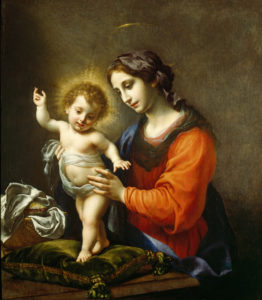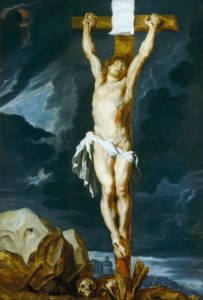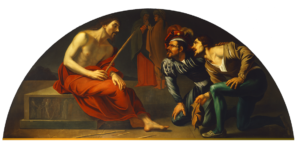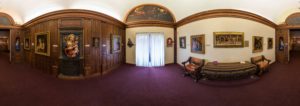Guido Reni is one of the foremost artists of the Bolognese school. Learn about his rendering of the four gospel writers from the founder of M&G, Dr. Bob Jones, Jr.
Tag Archives: baroque art
Art historian Georges Marlier describes The Holy Family in the Carpenter Shop as “a magnificent work which equals the most beautiful Caravaggio.”
The extraordinary life-like quality of the characters in this work illustrate why Francois de Troy was one of the 17th century’s most popular portrait painters.
Salvator Rosa’s panoramic view of Christ’s baptism is not only a beautiful illustration of the Savior’s humility but a stunning example of 17th-century landscape painting.
Domenico Zampieri’s St. John the Evangelist is not only a stunning example of the classical Baroque style but arguably one of the most important 17th-century pictures in America.
This arresting Mary Magdalene Turning from the World to Christ identifies Jan van Bijlert with the Utrecht Caravaggisti. The work is a beautiful blending of dramatic qualities of naturalism with the brilliant precision of classicism.
Although indebted to Italian painting, Philippe de Champaigne is unique in his ability to combine French elegance with profound psychological realism.
Christ on the Cross
Oil on panel, c. 1610, branded on reverse with the seal of Antwerp Guild of St. Luke
Peter Paul Rubens
Flemish, 1577–1640
So they took Jesus, and He went out, bearing His own cross, to the place called The Place of the Skull, which in Aramaic is called Golgotha. There they crucified Him, and with Him two others, one on either side, and Jesus between them. John 19:17,18
Christ on the Cross is one of M&G’s better-known paintings, due in part to the great master who created it. Peter Paul Rubens was born in Seigen, Germany and reared Roman Catholic. At age 12, his family returned to Antwerp, where he received a classical education, typical of the influence of Renaissance Humanism. In the Netherlands, he more than likely apprenticed under the leading artists of the day including Tobias Verhaect, Adam van Noort, and Otto van Veen. By 1598, he obtained the status of a master painter and entered the Antwerp Guild of Saint Luke, similar to a union for artists.
To continue his training, he moved to Italy two years later, where exposure to masterworks by artists like da Vinci, Michelangelo, Titian, and Caravaggio further influenced his developing style. During his eight years on the peninsula, he completed commissions for nobility and churches in both Italy and Spain, spending much of his time serving the Duke of Mantua. By the time he returned to Antwerp in 1609 his renown as an artist preceded him. In his lifetime he filled hundreds of commissions, served as a court painter (in Italy and the Netherlands), diplomat, and ambassador.
As the head of a large studio, he employed as many as three hundred assistants to help him meet the commissions he received from European kings and aristocracy. His workshop included artists who specialized in certain parts of a painting’s composition such as animals, flowers, or physical features. Although, Rubens most likely often painted the hands, feet, or faces of individuals. One of his best-known students is Anthony van Dyck, also represented in M&G’s collection. Rubens’ pageant-like paintings represent the apex of the High Baroque style. He stands as one of the greatest, if not the greatest, baroque artists of the Golden Age.
According to several specialists, M&G’s painting is recognized as one of Ruben’s better works. Likely, this work was a modello or prototype that would be referenced by an assistant to copy and complete a larger, commissioned version, which may explain some of the unfinished elements such as the absence of the crown of thorns and writing above Christ’s head.
Additionally, some stylistic features are distinctive to this specific painting including the single cross instead of three and a nail for each appendage. However, Christ’s position with his arms spread upward instead of outward represents a turning point in Christian iconography. In an exhibition catalog, former North Carolina Curator David Steel, explains Rubens’ novel depiction: “Rubens’ Christ suffers heroically, his muscles tense, his fingers clenched, and his arms raised almost straight above his head, thrusting his torso outward. This image emphasizes the physical sacrifice which Christ suffered on behalf of mankind, yet his upward straining, restated in the staves below, suggests his ultimate triumph.”
Of the three crosses on Golgotha, Christ was in the middle, the place reserved for the most notorious of lawbreakers. Rubens presents Christ, the perfect Son of God, as the singular focus of punishment and suffering, which the Apostle Paul emphasizes in II Corinthians 5:21, “He hath made Him to be sin for us, who knew no sin; that we might be made the righteousness of God in Him.” Meditate and marvel at the wonder of God’s crucified and resurrected Son during this Easter season!
John Good, Security Manager and Docent
Published in 2020
The Mocking of Christ
Oil on canvas
David de Haen
Dutch, c. 1597-1622
And when they had platted a crown of thorns, they put it upon his head, and a reed in his right hand: and they bowed the knee before him and mocked him, saying, Hail, King of the Jews!
Matthew 27:29
Artist David de Haen is the creator of this interesting canvas, which is called a lunette due to its half-moon shape. The painting is a variant copy painted by the artist of the original subject (and same shape) created for the Pietà Chapel in San Pietro de Montorio in Rome. The original lunette was designed to hang above the large altarpiece depicting Christ on The Way to Calvary. The church has multiple small chapels decorated by various prominent Italian painters from the sixteenth and seventeenth centuries; however, two seventeenth-century Dutch painters are also represented, and de Haen is one of them.
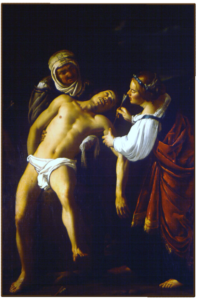 De Haen was born in Amsterdam sometime around 1597 and lived very briefly—just 25 years—with much of his time spent in Rome. Before his death in 1622, he created some notable works including the Entombment, which was destroyed in Berlin during World War II. The commission for the Pieta Chapel was shared with Dirck van Baburen, an artist also represented in M&G’s collection with St. Sebastian Aided by St. Irene. Both de Haen and Baburen were influenced by Caravaggio’s dramatic style. After his time in Rome, Baburen returned home to Utrecht, where he is credited as a key influencer of the Utrecht Caravaggisti—a group of artists following Caravaggio’s well-known trademarks of realistic representations of people and stark contrast of brilliantly lit scenes against darkly shadowed settings.
De Haen was born in Amsterdam sometime around 1597 and lived very briefly—just 25 years—with much of his time spent in Rome. Before his death in 1622, he created some notable works including the Entombment, which was destroyed in Berlin during World War II. The commission for the Pieta Chapel was shared with Dirck van Baburen, an artist also represented in M&G’s collection with St. Sebastian Aided by St. Irene. Both de Haen and Baburen were influenced by Caravaggio’s dramatic style. After his time in Rome, Baburen returned home to Utrecht, where he is credited as a key influencer of the Utrecht Caravaggisti—a group of artists following Caravaggio’s well-known trademarks of realistic representations of people and stark contrast of brilliantly lit scenes against darkly shadowed settings.
Dr. Jones Jr., M&G’s founder, acquired the painting for the Collection in 1986 and explained his fortuitous find, “It came up in an auction at Christie’s, and I noticed in the catalog that, when I measured it and checked the proportions, they exactly fit the end of the room (Gallery 5); so I bought it and put it here, although it is later than the other pictures in th[at] small gallery.”
A closer study of M&G’s painting reveals two men mocking Christ; both are dressed in period clothing of de Haen’s day. Two, less obvious individuals are seen in the background and could possibly represent Pilate and Herod or Caiaphas and his father-in-law Annas. The bench on which Christ is seated may allude to the stone slab that will ultimately entomb Him. The stone’s sculptural relief is similar to carvings found on Roman marble and limestone sarcophagi, which sometimes depicted narratives from the person’s life.
As you enter this Easter season, consider these words written by one of His closest followers, the apostle Peter: “For Christ also hath once suffered for sins, the just for the unjust, that He might bring us to God, being put to death in the flesh, but quickened by the Spirit” (I Peter 3:18).
John Good, Security Manager and Docent
For Further Study:
Podcast about David de Haen by Dutch expert Dr. Wayne E. Franits
About the artist himself
Published in 2020
Monthly Update
Sign up here to receive M&G’s monthly update and collection news!
EXPLORE More Online Features
Speakers Bureau
We can speak for your retirement group, civic club, church fellowship, or book club. Contact us here or at 864-770-1331.
Support Our Work
Make a Gift to M&G to help our current work and future plans.
